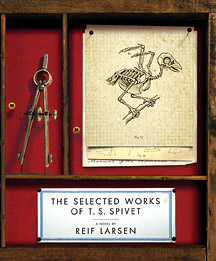Tecumseh Sparrow Spivet, the narrator of Reif Larsen's debut novel, is a twelve-year-old boy with a mind and a heart as wide open as the landscape around his home, the Coppertop Ranch. It's located 4.73 miles north of Divide, Montana, which in turn is just south of the continental divide, after which it is named. Divide once had a saloon and a railroad depot, but now the freight trains barrel past the sage.

While T.S. has little in common with his father or his sister, who pines for pop culture, his mother, whom T.S. calls Dr. Clair, is a fellow scientist, an entomologist. His diagrams of her beetles have launched him on a career making maps and illustrations for the Smithsonian, which, unaware of his age, has offered him a prestigious prize that he must travel to Washington, D.C., to accept.
Without telling his parents, T.S. stuffs a suitcase with mapmaking gear and stops an eastbound freight train by coloring the white "Go" light on the signal post with a red Sharpie marker. He narrates his adventures and his observations of America like a modern-day Huck Finn. In Chicago, the sight of boys wearing calf-length blue-jean shorts leads to a study entitled "When Did a Short Become a Pants? (and Other Modern Dilemmas)." He counts people traveling alone: of the ninety-three people he observes from the train, fifty-one are solitary. He labels this study "The Map of Accompaniment; or Loneliness in Transit" and calculates that "of these, 64 percent were listening to earphones or talking on cellular telephones, perhaps to distract themselves from the fact that they were traveling alone." He thinks for a moment and then erases the number fifty-one, poignantly replacing it with fifty-two. "I was now one of them."
Larsen tells Spivet's story at a leisurely pace, and reading it can be slow going, with frequent stops to absorb the drawings, maps, and sidebars with which he fills the book's margins. It can be tempting to whip through the body text, skimming or skipping the marginalia, but that would miss the point: T.S.'s digressions are not footnotes so much as the wanderings of a very curious child's mind and his attempts to make sense of his world. He wrestles with big demons in these little sidebars: his parents' apparently loveless marriage, for instance, and the death of his younger brother in an accident for which T.S. holds himself partly responsible. One of the book's most moving diagrams is of rifles: only the little Winchester has a barrel short enough for a ten-year-old boy to pull the trigger while pointing the gun at his face.
In this classic coming-of-age story, T.S. encounters real dangers, and hurts both physical and emotional, but his greatest disillusionment may be intellectual. When he reaches the Smithsonian he discovers the scientists he has idealized from afar to be pompous phonies more interested in advancing their own reputations than in advancing knowledge.
If the arc of T.S. Spivet's journey recalls Huck Finn's, his encounter with the science establishment brings to mind another young traveler: Antoine de Saint Exupéry's Little Prince, with his wise wariness of both grownups and blinkered science. T.S. Spivet is every bit as wise, and he inspires the same affection. He's a complete charmer.





